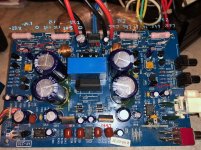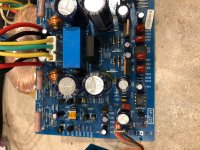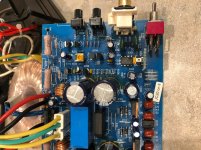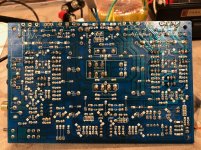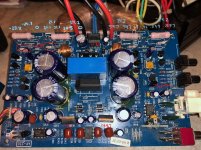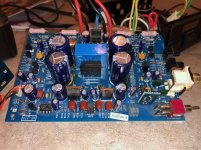I recently moved so I pulled this back out of the closet to see if I can get this running for an office system.
Issue - with a DBT the relay would click in and out every 1/2 second, due to DC on the speakers. I tried with 25, 40 and 60w bulbs and the only difference is the speed of the clicking and with a 60w bulb the power transistors would start to heat up. I found a faulty B817 power transistor and changed all of them for similarly matched Hfe 2SC3519A and 2SA1386A, which seem to match pretty well. Still wasn’t working and I had to move.
Ahead 8 months – and I’m trying to revive this little amp
First thing I did was pull all the transistors and test with a DMM and a transistor tester (from eBay) and only found one bad small signal transistor (Q202) and replaced it with a suitable replacement I had on hand (orig. c639, replaced with a leg-adj., and reversed C2240) for now and will get a correct one once it is back running.
I put all the small-signal transistors back in the PCB, but left out the driver/power transistors to do some testing.
Issue without the power transistors installed -
Left channel 220r resistors (R225/R227) in-front of 0.22r emitter resistors are getting quite hot - small amount of smoke with a 60w bulb in the DBT. Right channel has no heat on those same resistors.
I took some voltage readings and show ~24vDC on those resistors (w 25w DBT in place).
I included a picture with voltages taken with the black DMM lead on the black speaker connector and probing with the red lead (again with 25w DBT in place) ~24vDC on the Collector and -23vDC on the Emitter of the power transistors, but when the relays clicks out of circuit (takes 5-6 minutes with the Power Transistors removed) I get -5vAC on the Base and Emitter, but still have 24vDC on the Collector. Not sure what that tells me/you if anything.
If AC is getting through, does that mean a Capacitor is bad? I get voltage leaking across C207 and C209, which appear to be 47pF and a 33pF. The electrolytics look OK, no bulging or leaking, and the two I pulled tested within spec, but I haven't tested all of them out of circuit.
I don't have, and cannot find a schematic - so I'm a little lost on verifying resistor values and mainly checked for reasonableness (channel to channel) and that none were OL, and I have not found any that seem out of spec.
Issue - with a DBT the relay would click in and out every 1/2 second, due to DC on the speakers. I tried with 25, 40 and 60w bulbs and the only difference is the speed of the clicking and with a 60w bulb the power transistors would start to heat up. I found a faulty B817 power transistor and changed all of them for similarly matched Hfe 2SC3519A and 2SA1386A, which seem to match pretty well. Still wasn’t working and I had to move.
Ahead 8 months – and I’m trying to revive this little amp
First thing I did was pull all the transistors and test with a DMM and a transistor tester (from eBay) and only found one bad small signal transistor (Q202) and replaced it with a suitable replacement I had on hand (orig. c639, replaced with a leg-adj., and reversed C2240) for now and will get a correct one once it is back running.
I put all the small-signal transistors back in the PCB, but left out the driver/power transistors to do some testing.
Issue without the power transistors installed -
Left channel 220r resistors (R225/R227) in-front of 0.22r emitter resistors are getting quite hot - small amount of smoke with a 60w bulb in the DBT. Right channel has no heat on those same resistors.
I took some voltage readings and show ~24vDC on those resistors (w 25w DBT in place).
I included a picture with voltages taken with the black DMM lead on the black speaker connector and probing with the red lead (again with 25w DBT in place) ~24vDC on the Collector and -23vDC on the Emitter of the power transistors, but when the relays clicks out of circuit (takes 5-6 minutes with the Power Transistors removed) I get -5vAC on the Base and Emitter, but still have 24vDC on the Collector. Not sure what that tells me/you if anything.
If AC is getting through, does that mean a Capacitor is bad? I get voltage leaking across C207 and C209, which appear to be 47pF and a 33pF. The electrolytics look OK, no bulging or leaking, and the two I pulled tested within spec, but I haven't tested all of them out of circuit.
I don't have, and cannot find a schematic - so I'm a little lost on verifying resistor values and mainly checked for reasonableness (channel to channel) and that none were OL, and I have not found any that seem out of spec.
Attachments
Well - I put the power transistors and the 669A (I think this controls bias) back on the heatsink after checking all components and re-soldering most of the small transistors.
But I have the same issue - relay clicking in and out. Interesting part is if I adjust the bias on the right channel, the DBT glows brighter and the relay clicks in-and-out faster and vice-versa if I turn it down.
The left channel does not change if I adjust the Left bias.
Heatsink does not get nearly as hot, even with a 60w bulb in the DBT?
I also can't get any valid voltages on the +12V, or +/-15 linear ICs, which previously they would go up, until the relay clicked out, then start from 0 and build back up until the relay clicks out again.
Starting to think I might be better off to just gut this and substitute a different amp board and use the case, psu and heatsink?
But I have the same issue - relay clicking in and out. Interesting part is if I adjust the bias on the right channel, the DBT glows brighter and the relay clicks in-and-out faster and vice-versa if I turn it down.
The left channel does not change if I adjust the Left bias.
Heatsink does not get nearly as hot, even with a 60w bulb in the DBT?
I also can't get any valid voltages on the +12V, or +/-15 linear ICs, which previously they would go up, until the relay clicked out, then start from 0 and build back up until the relay clicks out again.
Starting to think I might be better off to just gut this and substitute a different amp board and use the case, psu and heatsink?
Uploaded a picture with voltages for the driver and power transistors. Hoping someone can guide me where to look for the fault, because I have checked most of the resistors and transistors and can't find a bad part at this point.
Attachments
Best way to approach things is with no power.
Test all the components best you can and see which ones are faulty.
I had a fault once where everything tested fine but amp didnt work right.
I then took out all transistors and checked them on a semiconductor analyser and the gain of one transistor was 1 !
Another time I couldn't find a fault after checking all components.
Turned out some !"£$%^ had tried to fix it before me and put in a wrong type transistor ! It was pnp instead of an npn and the number had worn off the transistor.
Test all the components best you can and see which ones are faulty.
I had a fault once where everything tested fine but amp didnt work right.
I then took out all transistors and checked them on a semiconductor analyser and the gain of one transistor was 1 !
Another time I couldn't find a fault after checking all components.
Turned out some !"£$%^ had tried to fix it before me and put in a wrong type transistor ! It was pnp instead of an npn and the number had worn off the transistor.
Try a 100W bulb. With the lower wattage bulb you can get into a situation where the unit tries to turn on and draws current - The bulb gets brighter (and it's resistance increases) - the unit sees a low voltage and shuts down. Rinse/Repeat.
I may have forgot to mention I did try a 100w bulb and it has the same behavior. Just cycles the relay on and off and that left side gets hot.
Best way to approach things is with no power.
Test all the components best you can and see which ones are faulty.
I had a fault once where everything tested fine but amp didnt work right.
I then took out all transistors and checked them on a semiconductor analyser and the gain of one transistor was 1 !
Another time I couldn't find a fault after checking all components.
Turned out some !"£$%^ had tried to fix it before me and put in a wrong type transistor ! It was pnp instead of an npn and the number had worn off the transistor.
Good ideas so thanks. Without a schematic I have tested all the resistors and compared side to side for consistency. I also pulled all the transistors and tested with a meter, replacing the only one that showed out of spec. Also the relay since I had one on hand. Didn’t change anything.
I’m not sure if there is a good option since I can’t find a schematic and don’t know enough yet to trace the entire circuit.
Thanks for the insight, maybe I missed something and will catch it going back through the amp again more carefully.
- Status
- This old topic is closed. If you want to reopen this topic, contact a moderator using the "Report Post" button.
- Home
- Amplifiers
- Solid State
- Parasound Zamp v1 Relay clicking in and out
